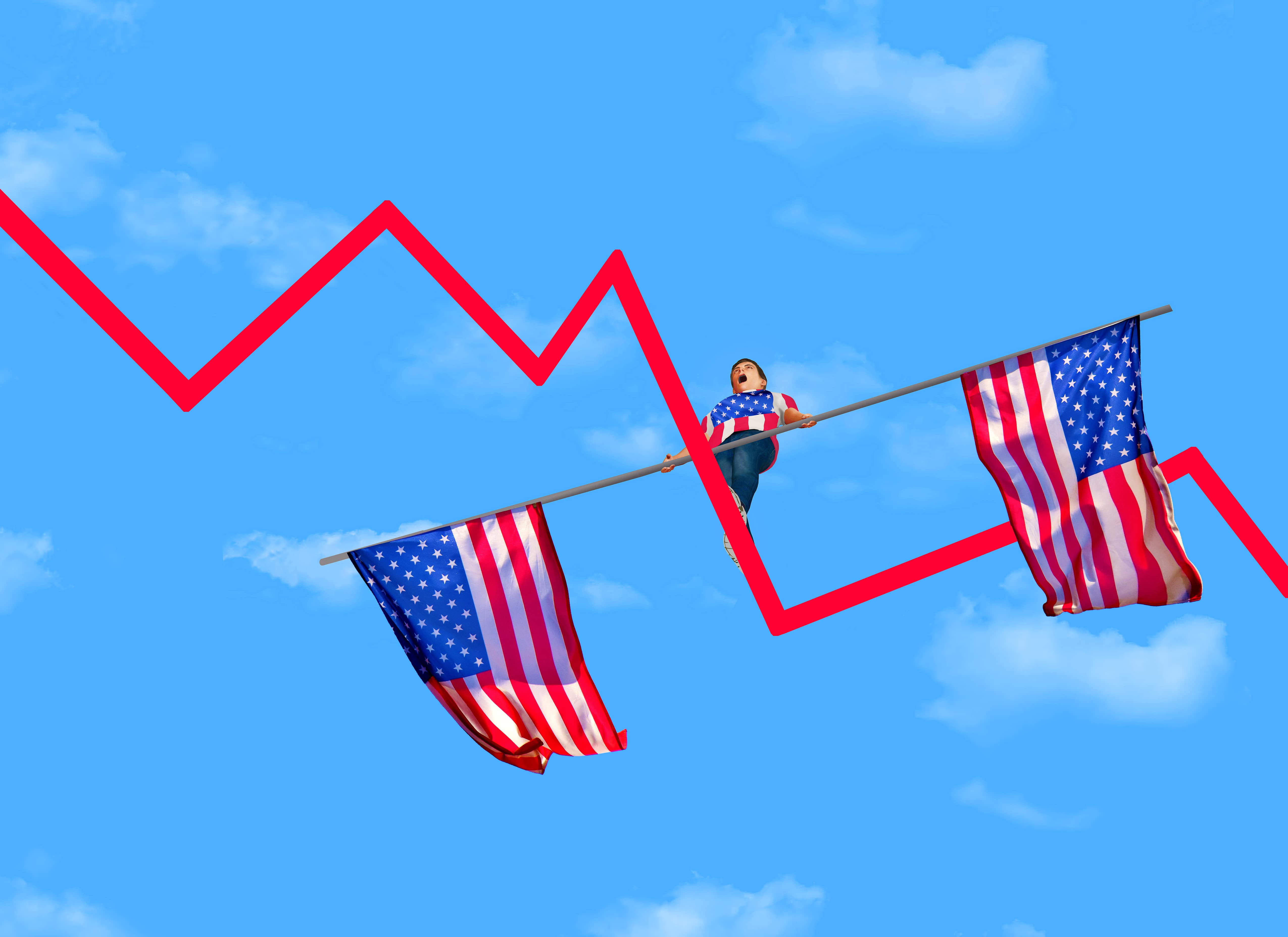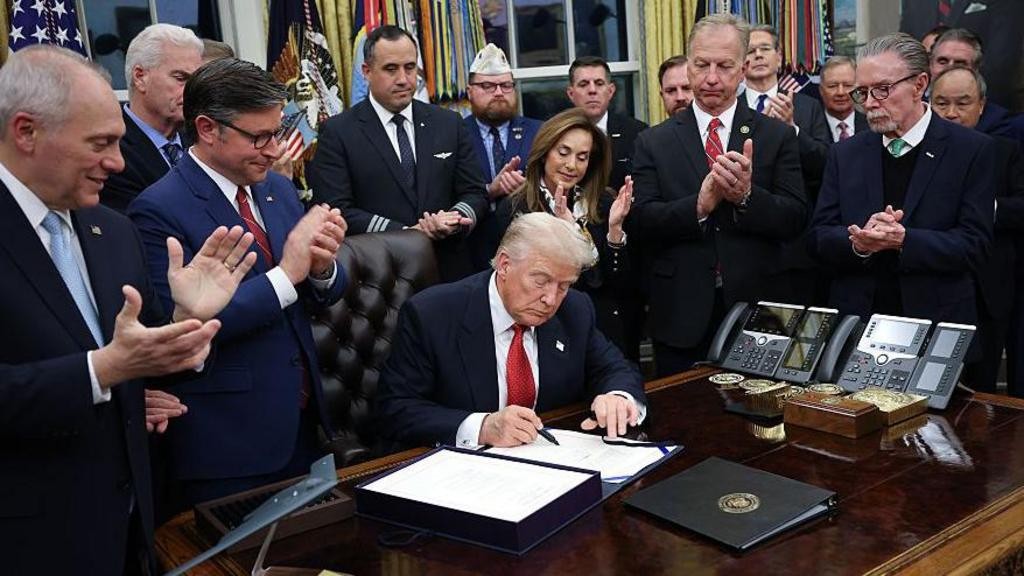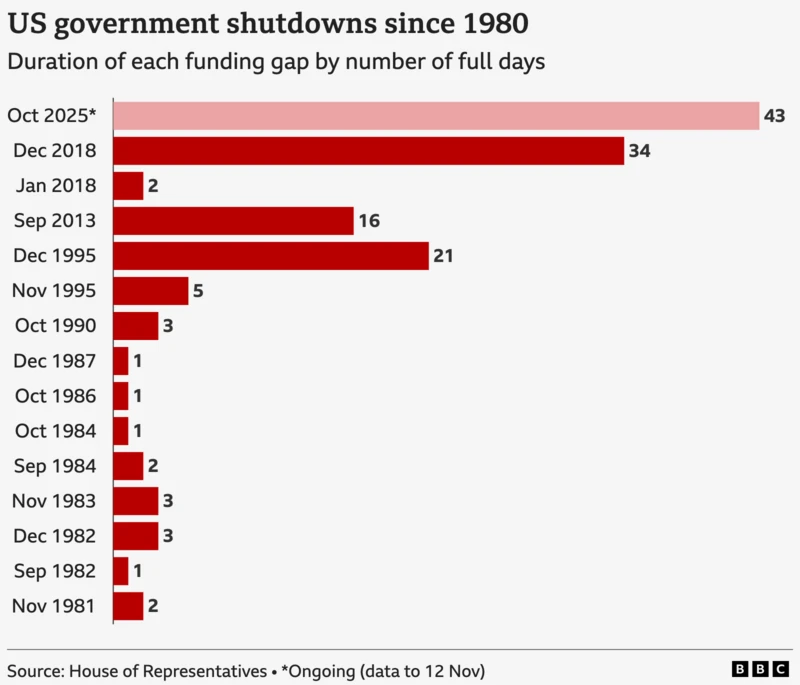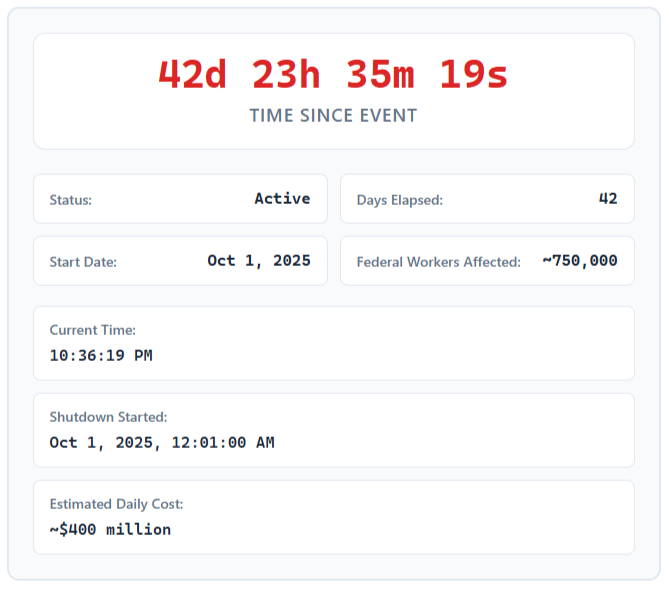市场资讯及洞察

The longest government shutdown in US history has finally ended after 42 long days.
After a month and a half of political theatre, seven Democrats and one independent broke ranks and voted with Republicans to pass a stopgap measure. The Senate went 60-40, the House followed 222-209, and Trump signed it hours later.
The legislation includes three-year appropriations for the Agriculture Department, FDA, military construction, veterans affairs, and congressional operations, along with restoration of pay for federal workers and reversal of Trump administration layoffs through January.
However, the most contentious issue, healthcare subsidies, has been kicked down the road to a December Senate vote.

COVID-era ACA subsidies expire at year-end. When they do, premiums for the average subsidised household will more than double from $888 to $1,904 per year, with an estimated 3.8 million people losing coverage entirely.
If the December vote fails, which is likely considering how far apart the two parties are on the topic, we could see a new shutdown begin in January.

What Happens Next?
This Week:
- Federal employees return to work.
- Paychecks start flowing again.
- SNAP benefits get restored for 42 million people, though heating assistance won't come back for weeks.
- National parks reopen.
- Airports start to go back to normal.
December:
- Senate votes on healthcare subsidies. It will probably fail.
- Premium notices continue to be sent showing 2026 costs doubling.
January 30:
- Government funding expires.
- We do this whole thing over, except now the healthcare subsidies have already expired.
- If Republicans and Democrats remain divided on budget priorities, another shutdown will likely begin.
By the Numbers:
Over the past 42 days, approximately 750,000 federal workers have been furloughed. Another two million worked without pay. Over 42 million had their food assistance delayed. And the FAA cut flights by 10% because air traffic controllers stopped showing up to work.

Further concern is the "data blackout" that has hampered Federal Reserve decision-making. Key economic indicators, including jobs reports, were suspended, leaving the Fed blind during an active rate-cutting cycle.
Meanwhile, separate analyses from Challenger, Gray & Christmas showed layoffs surged 183% in October, which would make it the worst October for jobs since 2003.
The Bottom Line
Today’s deal ended the shutdown, but it didn’t actually solve anything. The deal essentially kicks the can down the road to January while leaving the healthcare crisis unresolved.
With both parties divided on healthcare and spending priorities, and Trump lacking a comprehensive plan to address rising premiums and high deductibles, a resolution in the December vote seems unlikely.
If no compromise is accepted by the time Government funding expires on January 30, another shutdown is almost inevitable.
Impact of Australian Jobs Reports and U.S. Shutdown End on the Aussie


EU Recovery Fund After a standoff between the EU and Germany, following a critical ruling on ECB’s quantitative easing program by Germany’s constitutional court, the gradual reopening of economies of member states within the Eurozone has brought some optimism. The downside risks for the Eurozone and its shared currency have somewhat eased on the fact that Europe, which was the epicentre of COVID-19 after China, might have gone through the worst phase of the pandemic. The sentiment for the Euro was also buoyed by the EU Recovery fund proposed by Chancellor Angela Merkel and President Emmanuel Macron to help Europe’s mostly hit countries.
Unfortunately, the optimism over the coronavirus fund proposal, which aims to show unity in overcoming the crisis and to achieve quicker economic recovery, was short-lived. Europe’s Frugal Four Amid an unprecedented crisis, the Franco-German proposal was to provide support and reinforce EU financial relations and show that Europe is standing together. Austria, Denmark, the Netherlands and Sweden, dumbed as the “ frugal four ” put forward a counter-proposal that highlights the diversion of opinions in helping the Southern members states.
Grants or Loans The Franco-German proposal is about “overcoming the crisis united and emerging from it stronger ”. Both leaders proposed to make outright grants to help countries in need. They want to launch a temporary fund of 500 billion euro for EU budget expenditure: “This would not provide loans, but rather budget funding for the sectors and regions hit hardest by the crisis.
We firmly believe that it is both justified and necessary to now provide funding for this from the European side that we will gradually deploy across several European budgets in the future.” In contrast, the frugal four wishes to provide loans rather than grants to southern European countries and expect the recipients of loans to comply with the fundamental principles of the EU and commit to strong reforms in repaying the loans. Their two-year and “one-off” proposal appears to also outline how those countries should use the funds and target sectors that are mostly hit based on an assessment. The coronavirus pandemic is testing the solidarity of European members and is threatening to reawaken a euro crisis.
Southern countries like Greece, Italy and Spain lacked the fiscal space they need to put forward an economic stimulus package to support their economies, compared to Northern countries. Disparity? Compromise?
Both proposals are saying “ yes ” to emergency aids to assist with recovery, but the disparity lies on how the funds will be financed to respond to the economic wreckage. The size of the emergency fund, the conditions of the funds or whether it will be grants or loans will be a compromise the markets are expecting to see. However, the type of compromise might be a key factor in determining the relationships of EU members.
Unprecedented times probably need unprecedented Unity. Euro – The Shared Currency The fact that Europe may have gone through the worst phase of the coronavirus has somewhat eased the downside risks of the shared currency. But the current geopolitical tensions with China and uncertainties on the EU Recovery plan are putting a lid on the upside momentum of the Euro.
After the sharp plunge in March, the EURUSD pair has been trading within the 1.08 to 1.09 range. Yesterday, the better-than-expected IFO Surveys in Germany has helped the pair to hold ground and hover around the 1.09 level. The recovery plan could mitigate the selling pressure and allow a probable move above 1.10 level if there is a compromise that satisfies the frugal four.
EURUSD Source: Bloomberg Terminal The immediate attention turns to the European Commission which is supposed to unveil a draft recovery plan on May 27 th, 2020. About GO Markets GO Markets was established in Australia in 2006 as a provider of online CFD trading services. For over a decade, we have positioned ourselves as a firmly trusted and leading global regulated CFD provider.


The Logistics Company has reported a 27% decline in net profit (after tax) for the six months ended 31 December. The drop in profit is mainly due to higher costs on: Fuel Transport Brexit-proofing costs. The company was also deprived of the one-off tax benefit of US$130 million from a year ago.
Below is a summary of key metrics: Source: www.brambles.com With respect to the IFCO reusable plastic container business, the Chief Executive, Mr Chipchase did not provide any concrete information and said that the process “is not sufficiently” advanced, further adding that the company has not yet made any decisions on whether they will “sell” or “de-merge” it. Its share price dropped to a low of $10.85 which is a drop above 3% before rebounding slightly. As of writing, it is trading at $11.04:


Central banks of major economies like the US, UK and Japan turned to quantitative easing (QE) at a time where they were unable to push interest rates any lower. The European Central Bank (ECB) launched its first large scale of asset purchases in 2015 and was among the latest central bank to join the QE bandwagon. How QE works The ECB adopted the QE program to address the risks of a prolonged period of low inflation and help the Eurozone to return to the desired inflation level.
The QE, also known as the Asset Purchase Program (APP), consists of: Corporate Sector Purchase Programme (CSPP) Public Sector Purchase Programme (PSPP) Asset-backed Securities Purchase Programme (ABSPP) Third Covered Bond Purchase Programme (CBPP3) On 13 December 2018, the ECB decided to end the net purchases under the APP and announced that it would keep reinvesting cash from maturing bonds for a long time after its first interest rate hike. Market Expectations As the economic sentiment in the eurozone is worsening rapidly, investors are expecting the central bank to announce a robust stimulus package at its next meeting on Thursday: An Interest Rate Cut and Resuming Quantitative Easing. However, we saw divergent opinions on whether the central bank should resume asset purchases.
An Interest Rate Cut An interest rate policy by itself might not be enough, as cutting rates that are already negative will bring little help to the markets. If the central bank resume bond purchases, it could boost monetary and financing conditions. However, we are seeing divergent opinions on whether the central bank should resume asset purchases.
QE2 – The Second Round of Quantitative Easing In the height of the eurozone crisis from 2011-2014, such policies were probably justified. The current weakness in the euro- area might not be weak enough to warrant such a step, and there is now much skepticism on recommencing such non-standard and controversial monetary policies. The ECB policymakers have also dampened expectations of the resumption of bond purchases lately.
Market participants were initially expecting Mario Draghi to end its term with a significant package of monetary stimulus before Christine Lagarde takes over. It was are largely priced-in and now that the expectations eased ahead of the meeting, we are seeing European bond yields bouncing off record lows. Money markets and the foreign exchange markets are still expecting a traditional monetary policy intervention – at least a 10-basis point rate cut.
The Euro received a boost on Monday on hopes of German fiscal stimulus, though some expectations of monetary easing have limited the gains. EURUSD (H4 Chart) Source: GO MT4 If the central bank failed to satisfy dovish expectations already instilled in the markets, the shared currency may get a boost. The EURUSD pair may be trading sideways around the 1.10 level ahead of the ECB meeting on Thursday.
The pair could pick up a strong bid if the central bank falls short of expectations.


The week kicked off with a series of ECB speeches, and markets participants were gearing up to have more updates on the Eurozone economy, interest rate and Italy. Investors were keen to see whether the ECB downplays the slowdown in the German economy and the Italian Budget risks. We bring you a summary of the main headlines following the speeches: ECB’s Praet Speech: Peter Praet is a member of the ECB’s Executive Board since 2011.
The most captivating headlines from the latter are probably: “ The eurozone has lost some growth momentum, and headwinds are becoming increasingly noticeable.” He also argued that there is limited spillover from Italy so far. Praet acknowledged how the factors related to protectionism, financial market volatility and vulnerabilities in emerging markets are creating headwinds. He reiterated that the ECB policy will remain predictable and will proceed at a gradual pace.
He mentioned that it would need a big change in scenarios not to abide by rate guidance. ECB’s Nowotny Speech: Ewald Nowotny is the governor of the National Bank of Austria and member of the European Central Bank (ECB)’s governing council. Nowotny discussed the quantitative easing program and that the ending process poses little risk to financial stability.
He believes that “ a well-communicated exit may benefit financial health and very low rates for a long time may impair stability ”. ECB’s Coeuré Speech: Benoît Cœuré is a member of the ECB's Executive Board. The speech was mainly focused on Growth, Europe and Togetherness.
His speech captures how to reap the benefits of the Single Market. He highlighted how Europe’s East is not catching up which might question the value of the EU. “There have been some notable improvements in certain countries over time, but in others the process of gradually catching up with their EU peers appears to have stalled, or even to have backtracked, in recent years.” “And if there is no credible prospect of lower-income countries catching up soon, there is a risk that people living in those countries begin questioning the very benefits of membership of the EU or the currency union.” ECB’s President Draghi’s Speech: The President provided further insights into the euro area outlook and the ECB’s monetary policy. “The data that have become available since my last visit in September have been somewhat weaker than expected.” “A gradual slowdown is normal as expansions mature and growth converges towards its long-run potential…. Some of the slowdowns may also be temporary.” “Underlying drivers of domestic demand remain in place.” Overall, he expressed that the ECB maintained their view that the economy was still in line with expectations.
However, inflationary pressures were lower than expected which means that while bond purchases are set to end in December, the ECB will maintain significant monetary stimulus due to the moderation in recent data.


Dissecting the FOMC Statement The US Federal Reserve cut interest rates overnight by 25 basis points, taking the US Federal Funds rate to 2.25%. The rate cut was mostly seen as a hawkish one. In the press conference, Chair Powell said that the central bank’s rate cut was a “mid-cycle adjustment to policy ” rather than “the beginning of a long series of rate cuts.” We have dissected the July FOMC statement in comparison with the June statement to highlight the changes for ease of reference.


Deutsche Bank Revives The Failure of Lehman Brothers Deutsche Bank’s woes dominated headlines this week. On Sunday, the multinational investment bank announced 18,000 job cuts around the globe by 2022 and shut down its global stock trading business as part of a sweeping overhaul. It was reported that the cuts had been anticipated for weeks.
We watched the staff of the German bank being laid off around the world including, Sydney, New York, and London offices this week. It was difficult to witness the lay-offs of the troubled bank without reviving the moments of Lehman Brothers. Since the 2008 financial crisis, the bank started its downfall over a series of costly scandals, alleged wrongdoing, and years of mismanagement.
The massive restructuring did little to boost investor sentiment. The market is worried that the overhaul is not enough to deliver shareholders’ value in the future. In the face of its large workforce cuts, there are concerns on the revenue stream from the core European retail and corporate banking.
Additionally, in the era of low global interest rates and an-already struggling European banking sector, Deutsche Bank’s restructuring does not inspire a lot of confidence. Just recently, the Chief Executive Officer, Christian Sewing was celebrating its first major win when Deutsche Bank passed the stress test after it repeatedly failed past exams. The bank’s share price has increased since the beginning of June.
However, this week were the bearer of bad news. The bank might not have anticipated the lack of optimism on the revamp plans. The market has doubts over the restructuring and the ability of the German lender to meet its 2022 profitability goal is highly questionable.
Its share price fell by more than 10% from a high of 8.22 last week to a low of 7.28 this week! Source: Bloomberg Terminal (1 Month Chart) The week got worse as Deutsche Bank is being dragged in a wider probe of a 1MDB scandal. The investigation adds to the list of other high-profile government probes.
The restructuring has not been met with optimism by global rating agencies as well. Now is probably not the time to test the buy the dip strategy.

